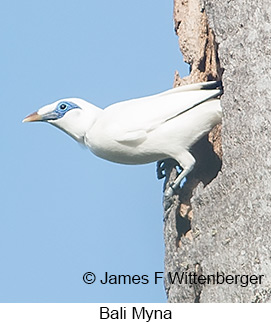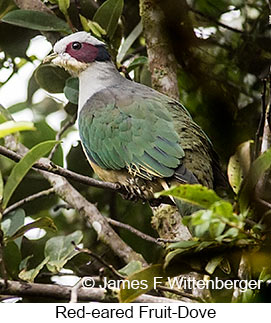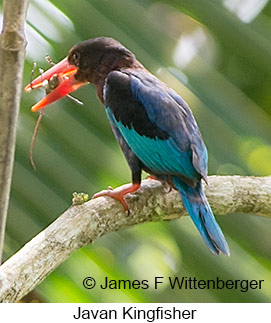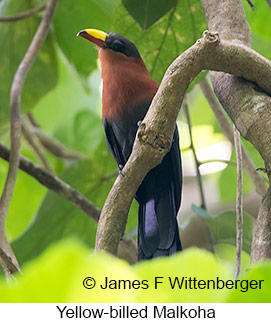ABOUT INDONESIA BIRDING

ASIA
INDONESIA
| # Species: | 1377 |
| # Excl Vagrants: | 1370 |
| # Endemics: | 455 |
| # Near Endemics: | 78 |
 Indonesia is a vastly complex and fascinating place. The country is poor and in some places densely populated, with nearly 10 million people residing in Jakarta and a million or more people in multiple cities on the islands of Java, Sumatra, and Sulawesi. Since the national boundary of Indonesia is arbitrary with respect to geography, it's convenient for birders to think of Kalimantan as being part of Borneo instead of Indonesia since it's the Indonesian portion of that island and to think of West Papua as part of New Guinea for the same reason.
Indonesia is a vastly complex and fascinating place. The country is poor and in some places densely populated, with nearly 10 million people residing in Jakarta and a million or more people in multiple cities on the islands of Java, Sumatra, and Sulawesi. Since the national boundary of Indonesia is arbitrary with respect to geography, it's convenient for birders to think of Kalimantan as being part of Borneo instead of Indonesia since it's the Indonesian portion of that island and to think of West Papua as part of New Guinea for the same reason.
In spite of the high population density and concomitant habitat destruction on some islands, Indonesia is of great interest to birders due to its high rate of endemism. Over 350 of the 1250 or so recorded bird species are endemics found nowhere else in the world. This high rate of endemism as well as great species diversity is due to the geological complexity of the country. Indonesia encompasses 17,508 islands on either side of the equator and straddles three tectonic plates that have been on a collision course for millions of years. As a result, the country has numerous volcanos, many still active, and is subjected to frequent earthquakes. Deep water trenches separate some of the islands from others, and these correspond to plate boundaries. The famed English naturalist, Alfred Russell Wallace came up with the theory of natural selection independently of Charles Darwin as a result of his studies of the islands. The Wallace Line was viewed by him as the faunal boundary separating the biozones of Asia and Australia. On the Asian side of the line are Sumatra, Java, and Borneo. On the other are Sulawesi, Halmahera, the Lesser Sunda Islands, the Maluku Islands, and New Guinea. A second line, known as the Webber Line named after the zoologist and biogeographer Max Carl Wilhelm Webber, more or less follows the deep water trench of the Lombok Strait and further separates Sulawesi and the Lesser Sundas from Halmahera and the Maluku Islands the New Guinea and is now considered to be the boundary between the Asia and Australia plates. The bioregion of Wallacea encompasses part of Indonesia and is a heart-shaped area that encompasses the islands east of the Wallace Line and beyond the Webber Line to include all the main island chains east of New Guinea. Hence, it includes Sulawesi, Halmahera, the Lesser Sunda Islands, and the Maluku Islands.
collision course for millions of years. As a result, the country has numerous volcanos, many still active, and is subjected to frequent earthquakes. Deep water trenches separate some of the islands from others, and these correspond to plate boundaries. The famed English naturalist, Alfred Russell Wallace came up with the theory of natural selection independently of Charles Darwin as a result of his studies of the islands. The Wallace Line was viewed by him as the faunal boundary separating the biozones of Asia and Australia. On the Asian side of the line are Sumatra, Java, and Borneo. On the other are Sulawesi, Halmahera, the Lesser Sunda Islands, the Maluku Islands, and New Guinea. A second line, known as the Webber Line named after the zoologist and biogeographer Max Carl Wilhelm Webber, more or less follows the deep water trench of the Lombok Strait and further separates Sulawesi and the Lesser Sundas from Halmahera and the Maluku Islands the New Guinea and is now considered to be the boundary between the Asia and Australia plates. The bioregion of Wallacea encompasses part of Indonesia and is a heart-shaped area that encompasses the islands east of the Wallace Line and beyond the Webber Line to include all the main island chains east of New Guinea. Hence, it includes Sulawesi, Halmahera, the Lesser Sunda Islands, and the Maluku Islands.
 The geology of the region is of interest to birders because the species composition and most notably, the endemics, are very different on either side of the Webber Line. Thus, the species on Halmahera are very different, for example, from those on Sulawesi, which is why the two islands are usually visited together on birding tours. The reason for the big difference is not that the islands are so far apart now. However, over the past millions of years, those islands have been gradually moving closer to each other. The ancestral species on Sulawesi were Asian, while the ancestral species on Halmahera were Australasian. Millions of years ago the islands were much farther apart. Many species could not cross the then much larger distance between them and so remained very distinctively different.
The geology of the region is of interest to birders because the species composition and most notably, the endemics, are very different on either side of the Webber Line. Thus, the species on Halmahera are very different, for example, from those on Sulawesi, which is why the two islands are usually visited together on birding tours. The reason for the big difference is not that the islands are so far apart now. However, over the past millions of years, those islands have been gradually moving closer to each other. The ancestral species on Sulawesi were Asian, while the ancestral species on Halmahera were Australasian. Millions of years ago the islands were much farther apart. Many species could not cross the then much larger distance between them and so remained very distinctively different.
Aside from Borneo and West Papua, New Guinea, birders have several main destinations in Indonesia. Most popular are tours to Sulawesi and Halmahera, which allow for birding on either side of the Webber Line. Less popular are tours to the Lesser Sunda Islands and Maluku Islands, both island chains featuring their own endemic species. The island of Sumatra also has its endemic birds, as well as many interesting mammals. Birding Sumatra is more difficult as facilities are rather basic and the birding on mountain trails, notably Mt Kericini, can be quite strenous. Birding on Java is challenging for a different reason. There, habitat degradation has been quite extreme. Nevertheless, some national parks offer excellent birding and the island has its own set of endemics. Java is also home to a number of primates and other mammals including the endangered Javan Rhinoceros in the little visited south. Since nearly all islands have their own set of endemics, some tours visit more remote islands. Occasional tours go to the small islands of Taluad, Sangihe, Togian, Taliabu, and Peleng near Sulawesi, while others cover some of the small islands around Sumatra such as Aceh, Simeulue, and Mentawai as well as less visited sites on Sumatra itself. Finally, birding cruises on the Banda Sea that separates the Lesser Sunda Islands from the Maluku Islands are conducted by some companies. These focus on the smaller islands, many uninhabited and not well explored, along with seabirds.
Most popular are tours to Sulawesi and Halmahera, which allow for birding on either side of the Webber Line. Less popular are tours to the Lesser Sunda Islands and Maluku Islands, both island chains featuring their own endemic species. The island of Sumatra also has its endemic birds, as well as many interesting mammals. Birding Sumatra is more difficult as facilities are rather basic and the birding on mountain trails, notably Mt Kericini, can be quite strenous. Birding on Java is challenging for a different reason. There, habitat degradation has been quite extreme. Nevertheless, some national parks offer excellent birding and the island has its own set of endemics. Java is also home to a number of primates and other mammals including the endangered Javan Rhinoceros in the little visited south. Since nearly all islands have their own set of endemics, some tours visit more remote islands. Occasional tours go to the small islands of Taluad, Sangihe, Togian, Taliabu, and Peleng near Sulawesi, while others cover some of the small islands around Sumatra such as Aceh, Simeulue, and Mentawai as well as less visited sites on Sumatra itself. Finally, birding cruises on the Banda Sea that separates the Lesser Sunda Islands from the Maluku Islands are conducted by some companies. These focus on the smaller islands, many uninhabited and not well explored, along with seabirds.
OTHER COUNTRIES
IN ASIA
BIRDING LOCALES
§ Includes Sarawak, Sabah, & Kalimantan
§§ Excludes Taiwan
§§§ Excludes Sarawak and Sabah on Borneo





